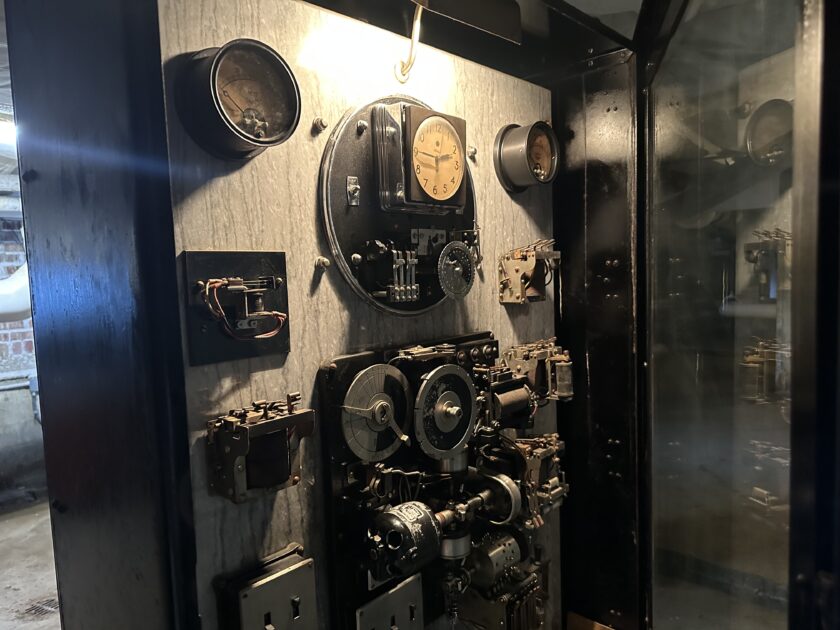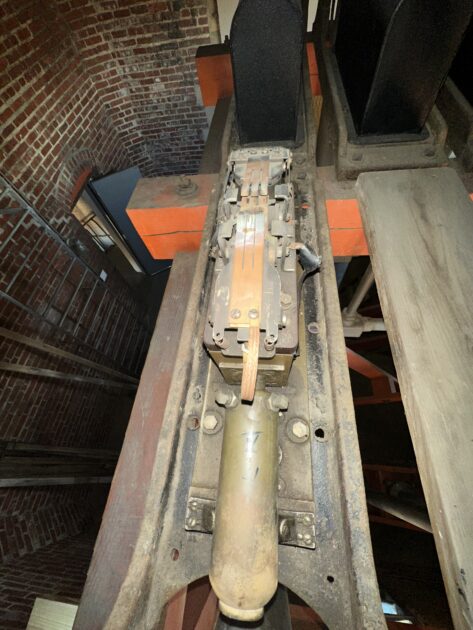
The hymnals that can be heard playing on campus throughout the day are not produced by real instruments. Rather, the bell sounds spewed from the speakers of the Kerns Religious Center were recorded on a CD and installed in the 1980s.
To hear authentic Deagan Tower Chimes, one must take a short walk to the Trinity Lutheran Seminary, the home of an original set of Deagan Tower Chimes.
Before the summer of 2022, this massive instrument was dormant, but because of the work of Richie Gregory and Paul Matthews, the chimes are operable.
According to Matthews, director of Facilities Management, the system was installed in 1926 in honor of Mary C. Schenk, whose family trust also donated the money needed for the restoration process.
Richie Gregory is a senior music education major and organist who has always been fascinated with tower bells. When he first saw the tower at the seminary, Gregory wondered if there was anything in the tower at all. Once he discovered that there were chimes in the tower, he was elated.

Gregory began by emailing various departments on campus, most of whom expressed interest in the renovation of the chimes but were prohibited from helping due to the estimated cost factor, said Gregory.
Gregory was eventually put in contact with Matthews. Matthews was convinced by Gregory to bring in experts from the field to give their insight. After looking over the entire system, they turned off the cut-off switch.
Unfortunately, when Gregory tried to play the chimes, he did not hear anything. However, he got a call from Matthews and his friends in the relay room exclaiming, “It’s working!”
Once they knew that the system was still intact, they began inspecting the clock, the relay box, the power supply and chimes. They determined additional resources needed to be consulted.
Gregory said, “To see that the university was interested and open [to the idea] of restoring the chimes with its original elements, I am very thankful for that.”

To start the process, the belfry, the tower structure that encloses the chimes, was cleaned and abated. The Deagan system, to the surprise of Gregory, was in phenomenal condition.
The structural integrity of the bronze chime bars, solenoids, relay and clock was strong given they were the original ones installed in the 20s.
Bill Pugh, former owner of Top Rung Inc., was brought in last November to consult on the project. Gregory, who checks the clock and chimes routinely, says most of what he learned about the system was due to Pugh’s expansive knowledge of Deagan instruments.
Understanding the mechanisms is essential to ensure that the chimes remain functioning properly.
The chimes can be activated either by the keyboard in Schenk Chapel or automatically by the Westminster clock in the basement of the seminary, which was finished being restored and reactivated two weeks ago.
The clock is programmed to ring the same sequence as the clock tower in the Palace of Westminster, also known as Big Ben.

Hence, the university’s chimes play the signature Westminster Quarters melody every 15 minutes.
Four notes make up the sequence: G#, E, F#, B, E. Every quarter hour, the sequence is played once more than it was played the previous quarter hour. At the top of the hour, the low F note is struck according to what hour it is.
This intricate system fascinates Gregory. He said:
“The clock activates a string of electro-magnetic processes every 15 minutes, causing the “music box” attached to the Westminster clock to turn on. There are four pins on the music box action which are responsible for an individual note in the tower.
The pins lift copper fingers, which then hit contacts, sending voltage to the notes corresponding solenoid in the relay box in the second-floor relay room. The relay room is home to the brass plungers; once the plungers make contact with the copper arms, 48 volts DC is sent to its corresponding striker solenoid in the belfry.
The belfry solenoid ejects the striker for the note into the side of the chime bar. This process is repeated for every note initiated from its pin on the clock.

When it finishes, it trips a relay to engage the low F, which is run on a mechanical timer to ensure the F only strikes and rings the correct number of times for the hour. When it finishes, the clock shuts off.”
The Deagan Tower Chimes owned by the university is “one of the small handful of Deagan Tower Chimes systems left in the country that actually works,” said Gregory.
According to the Chicago Museum, “Between 1920 and 1940, the [J.C] Deagan Company [of Chicago Il.] was bringing in a large share of its income from America’s churches, as aging houses of worship paid top dollar to have top-quality Deagan tubular bells installed in their carillon towers.”

Of the estimated 400 sold, the university owns the only one ever installed in the greater Columbus area.
Though Gregory is a senior, he hopes that the chimes continue to function well past his graduation. He and Matthews have set up precautions to ensure the chimes do not disrupt class, are clearly audible and are kept clean with regularly scheduled oils and maintenance.
The final step to this process is to schedule a student to play the chimes via the keyboard, ideally once a day for 5-10 minutes. The Deagan has the capacity to play 12 notes, but only five are currently being used.
In the future, Gregory hopes to elicit more help to restore the historic 1920s M.P Moller organ in Schenck Chapel to working order within the next year.
“This instrument could be used for chapel, functions and as a practice instrument for the growing number of organ students at Capital,” said Gregory.
This would bring the total number of the significant instruments on campus to three: the organ in Mees Hall, the organ in Gloria Dei Chapel and organ/keyboard in Schenck Chapel.



One thought on ““Resurrection of historic University asset,” student and faculty work to restore rare and historic Deagan Tower Chimes system”